__go to HOMEPAGE or here to go to PRODUCTS or here for a more detailed Installation Guide
Q & A Solar Water Heater Panels, Pumps and Controllers
1/ What is the approximate cost of fitting my own Evacuated
Tube Solar Panel system?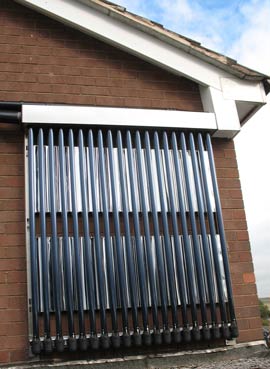
One panel, pipe work and all the associated equipment will cost around £700
2/ Do they only work in Summer?3/ Is it difficult to install?
No, anybody with reasonable DIY skills will be fine. You do not need
advanced plumbing or electrical knowledge and you will not be dealing
with mains electricity!
Help, support and advice are on hand and are free.
4/ Why do some installers charge over £6000 then?
Hmmm. You’ll have to ask them!
5/ I have seen you can make your own solar panel. Is that possible?
Yes. Many people have home made panels, which work well in the warmer months. See http://www.thegreenlivingforum.net/forum/viewtopic.php?f=23&t=6709
But with the much lower prices now available for the Evacuated Tube panels, the relative savings from making your own are very limited. Also, the greater efficiency of these newer technology panels more than pays back their investment. We often sell these panels to people who started by making their own and who are encouraged by the savings available from a more efficient Solar Collector.
6/ What is the difference between these Evacuated Tube panels and the Flat Plate Panels?
On a hot and sunny day they both offer good benefits. However, the newer technology of Evacuated Tube Panels has led to much greater efficiency in operation in less perfect conditions. This is most apparent in our changeable climate, where wind or weak sun can prevent the flat plate collectors from providing any useful heat. The Evacuated Tube collectors will continue to work in relatively overcast conditions when the traditional Flat Plate collectors cannot. As such, the Spring and Autumn seasons can offer good amounts of hot water and even in sub-zero conditions on bright Winter’s days, as the solar energy is trapped behind the vacuum, rather like a Thermos flask.
7/ How are they installed into a house plumbing system?
There are two main methods of connecting the panels to your hot water
system. The traditional “Indirect” method has been to run the heated
water through a second heat-exchanger coil in your hot water tank. This
often means buying a new hot tank as most will not have a secondary coil
fitted. The circuit is closed in a loop and anti-freeze can be added
against frost risk. A small expansion vessel will also be required to
manage the expansion of the water as it heats.
As a simple and inexpensive alternative, the Evacuated Panel can be
installed “Direct” to heat the actual water you will bathe in. A cool
feed is taken from the base of the hot tank, into the panel, and
returned back into the hot tank at the top, where the water is hotter
due to 'stratification'. This method requires minimal plumbing skills
or parts, so can easily be completed for under £60 (€70).
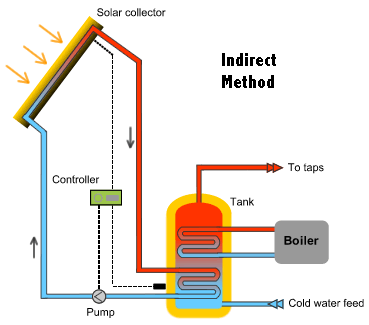

More detail on the installation process can be found HERE
8/ How many panels would I need?
This depends on the size of the household, the amount of hot water required and the position of the solar panel. As a guide, a family would need one or two panels.
9/ Can I add more panels later if one isn’t enough?
Yes, the panels are modular, so it is fine to fit one and add a second later if desired.10/ What is the best location to fit the panel?
South facing is the ideal, and anywhere between South East and West will give good results as the sun moves round. Some people fit two, one East and the other West facing due to the direction of their roof.
 11/ Do they have to be
fitted on a roof?
11/ Do they have to be
fitted on a roof?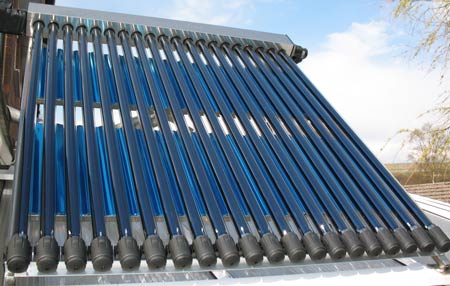
No. They will work at any angle greater than 20 degrees from horizontal, so they are often mounted upright on a gable wall. They can also be mounted on a flat roof or at ground level in the garden, using the stand that is included in the kit.
12/ Are they suitable for swimming pools?
Yes. You will need several to heat a pool as they contain so much water and most people use a heat exchanger to keep the chlorinated water from direct contact with the copper in the panel. We have done some successful work to develop a very simple DIY method of installing to a pool, you can see details of this here.
13/ What sort of pump do I need with my solar hot water
system?
A pump is needed to circulate water around your system to transfer
the heat from the panel to your hot water tank. There are two main types
of pump, being centrifugal or positive displacement.
The most obvious difference between these two options, is that of price.
We currently offer a well proven, efficient and very compact centrifugal
pump capable of handling the sorts of temperatures involved in solar
heating for under £32 delivered to you. These pumps use a spinning
impeller to push the water, and as such, can be restricted to achieve
lower flow rates as required to optimise your system.
A Positive Displacement pump works with a piston-like action and
therefore creates higher pumping pressures. This is not normally
necessary in the solar applications, and the price at around £150 or
more is a deterrent.
14/ What flow rate will I need from my pump?
Usually between 1.5 and 4 litres per minute is ideal. Much higher rates will reduce the temperature of the pumped water as it will have passed through the panel too quickly to have picked up the heat fully. The flow can be controlled and adjusted by fitting inexpensive gate valves in the connections to the hot tank.
15/ What sort of photovoltaic panel should I buy to power a 6Watt pump?
It is a widely accepted truth that photovoltaic panels will typically produce only around half of their rated wattage in UK conditions. Personal experience bears this out, so we would recommend buying a 12 volt panel of at least 12 Watts for a 6 Watt pump.
16/ What are the benefits and drawbacks of powering my system with a photovoltaic panel?
It is theoretically possible to use a PV panel to determine when the circulating pump switches in and out, thereby avoiding the need for a temperature difference controller. The simple idea is that the PV panel only produces enough power to run the pump when the sun is shining and that the sun must therefore be creating heat in your solar panel.
However, in practice, it is very difficult to ensure that the pump is being switched on at the most efficient time and you may actually be pumping heat out of your tank at some stages of the day. Most users report a need for extensive testing and experimentation to use this method satisfactorily.
PV panels are still relatively expensive, compared to the savings in electricity they produce. For example, my own system is mains-powered, running one of our Controllers and a 7 watt pump from a mains adaptor, at a measured cost of just 7p per week (£3.50 per annum) in electricity. Replacing the mains with a PV panel would represent a very long payback period for the cost of a PV panel at say £75! Nevertheless, many people are attracted to the idea of zero carbon emissions.
Tip: With modern switched power supplies being available for £10 or £15 (240V to 12V, 1Amp) it is often easier to set your system up using such a mains transformer and only consider adding the PV panel later.
17/ What would I need a Temperature Difference Controller for?
Flat Plate Collector panels have the disadvantage that they also operate as radiators, so circulating water at the wrong time causes heat to be lost from your hot water tank. The presence of sun on your PV panel (see Q16) does not necessarily mean you have hot water to collect. A controller ensures that the pump runs only when there is beneficial heat to harvest.
18/ How does a Controller work?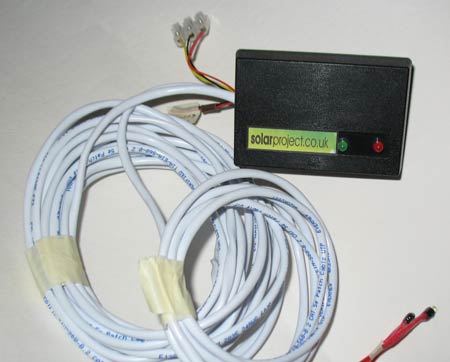
A Temperature Difference Controller is an electronic circuit with two
or more temperature probes. It compares the temperature of the water in
your panel with that in your hot water tank, to assess whether it is
beneficial to start pumping. Typically it'll look for a 6°C differential
before switching the pump on and it will continue to make this
assessment every 15 seconds, switching off before any cooling occurs.
The controller shown here is a 12 volt unit, operated by a microchip
which can be programmed to suit the customer's individual needs, with
features such as Frost control, which is particularly useful for
customers connecting evacuated tube panels in the direct (SolarTwin
style) method. You can read more on
this on my products page here
19/ What are the advantages of using a Controller?
The purpose of the controller is to optimise the efficiency of your
solar panel and to ensure heat is not wasted unintentionally. With
controllers starting at around £35 they are to be recommended strongly.
A controller is also very useful if you wish to use PV power. The most
effective method is to use the photovoltaic panel to maintain charge on
a 12-volt car battery and to power the pump and controller from that
battery. This set up gives the best performance from your solar water
panel without consuming any mains power.
Tip: Your local vehicle dismantler will have lots of good 12V car batteries that they need to get rid of. I usually reckon to pay around £10 for a heavy-duty battery or even less for a smaller model. As a guide, a 48 Amp/hr battery would run my pump for over 90 hours (about a fortnight) without any charge from the PV panel.
20/ Can I run my Central Heating from Solar Heated water?
Well yes, BUT! (and it is a big but) The major drawback to this is that the solar energy is strongest in Spring to Autumn when we don't need central heating and weakest we need it most (December) . It is possible to heat a body of water called a thermal store (usually a hot water tank but might be a swimming pool) and use that heat to pump round the CH system. The contribution it can make to heating costs will not be huge unless you have a large array of panels.
21/Where can I get unbiased advice about the merits of the different systems?
There is lots of advice on the Internet. You might start at Renewable Energy’s excellent site at http://www.reuk.co.uk/Evacuated-Tube-Solar-Water-Heating.htm
22/ How much of the sun's energy reaches the UK each month?
Monthly Irradiation Figures:
(Solar energy reaching each Square Metre of the earth’s surface at UK
latitudes)
|
|
Jan |
Feb |
Mar |
Apr |
May |
Jun |
Jul |
Aug |
Sep |
Oct |
Nov |
Dec |
|
kWh/day per metre |
0.64 |
1.17 |
1.94 |
3.22 |
4.17 |
5.00 |
4.44 |
3.61 |
2.78 |
1.67 |
0.78 |
0.47 |
As a guide, the average house uses around 3000 KWh of energy per year in providing hot water.
UK solar irradiation - Annual Total kWh/sq.m
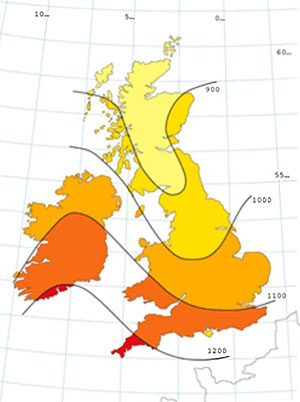 The anticipated level of Irradiation (Solar
Energy) can be used to assess the number of panels required for a given
property.
The anticipated level of Irradiation (Solar
Energy) can be used to assess the number of panels required for a given
property.
22/ What percentage of my hot water will come purely from the solar system in the UK?
The UK receives slightly more than half of the solar energy received at the equator, definitely enough to operate a solar water heating system. As you can see above, this varies depending on where you are in the country, with best returns in the south . A typical solar water heating system in the UK provides 50% - 60% of annual domestic hot water requirements. This is spread out over the year to approximately 90% in summer, 50% in spring, and 20% in winter. A solar system provides heat input even on cloudy days by utilising energy from diffuse light. In winter the system will pre-heat the water in the cylinder, meaning the solar system will make meaningful reductions to the gas, oil or electricity consumption throughout the year. The solar water heating system works alongside the existing hot water system. On cloudy days, the little sunlight there is will preheat the water in the cylinder - and the boiler or immersion heater will do the rest.
23/ Can I use Solar Panels with a combi boiler?
Combi boilers heat the water direct from the water main as it is called for, so don't have a store of hot water. This means that you need to fit a tank to store the heat during the day, ready for use when you need it. Using an additional function within our Controller, and a motorised valve, you can have your hot water needs fed direct from this hot tank if it has reached sufficient temperature, or routed through the Combi if it needs further boosting.
Many people fit a 'thermal store' (a tank of water that has a coil running through it). The store water is heated by Solar, the 'cold' supply to the boiler runs through the store's coil and is pre-heated before it enters the boiler. Thus the energy needed to give you hot water to the tap is much less and your bills will reflect that.
Not every boiler will accept a very hot supply and you will need to consult the Manufacturer to check. If it cannot, then a blender valve will solve the issue by feeding water to the boiler at say 25C instead, still providing great savings on energy.
24/ Will the flat packed panels fit in my car?
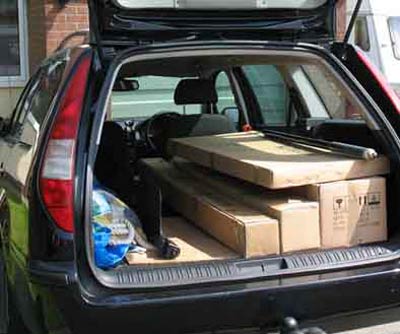 |
As I no
longer stock panels it will be necessary to speak to your supplier |
25/ What plumbing fittings am I likely to need to complete a Direct Installation?
Obviously this depends on the specifics of your current plumbing system but I have attempted to list the various items on a spreadsheet to assist the home installer. You can get most of the items from us or indeed any good plumbers merchant.
Click here to open the spreadsheet (you might need to have MS Excel on your pc to open this) The basic plumbing fittings will cost around £50, plus a Pump (circa £25) and a Controller (£45 to £99). Also shown is the schematic for Indirect Connection, on a separate tab in the worksheet.
|
26/ I have seen one of your pumps has a 2.3 mtr "HEAD". What does this mean and can I use it to pump water around a panel on my roof if that is higher than 2.3Mtrs? A Pump's HEAD is the height it is capable of pushing water up an open ended vertical pipe, as in a fountain. But as we use complete circuits for circulation this head limitation does not apply. Think of the solar circuit as being like a spinning wheel on an upturned bicycle. The weight of the part of the wheel moving upwards is counteracted by the half of the wheel that is moving downwards, so very little energy is needed to keep it spinning. But now imagine that you cut the wheel in half : - then it would need much more power to lift it up, just like a fountain. So the head is a limiting factor only in the non-closed circuit. I have made a short YouTube video to demonstrate the point -http://www.youtube.com/watch?v=5P144FcPXzo- but the quick answer to Q26 is probably YES! But you must get all the air out of the circuit for it to work properly. And if you would like a more powerful pump for your application I can offer similar pumps with a greater head of 5mtrs, still at 12V and around 14 Watts. |
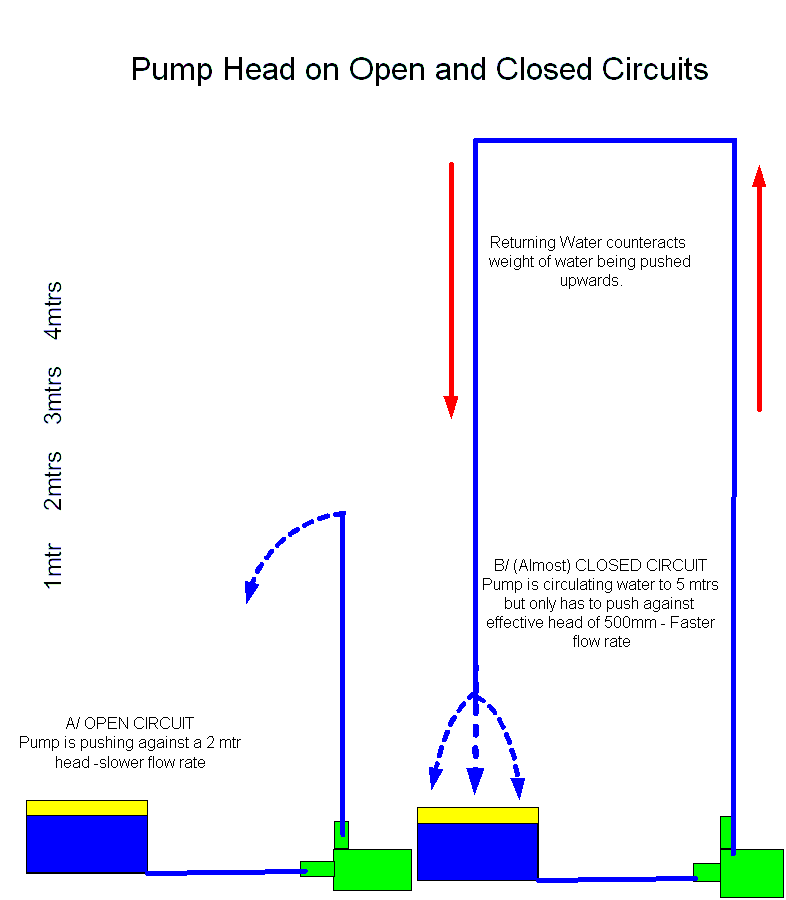 |
end-